University Assignment: Unit 33 Report - Medication in Social Care
VerifiedAdded on 2020/07/23
|8
|2210
|45
Report
AI Summary
This report provides a comprehensive overview of medication support within social care settings. It begins by outlining the relevant policies and legislation, such as The Medicines Act 1968 and The Health Act 2006, that govern medication use. The report then details the roles and responsibilities of various individuals involved, including care workers, support workers, registered managers, nurses, and pharmacists. It explores methods of accessing medical information, different routes of medication administration, and the various forms in which medications are presented. Furthermore, the report evaluates the use of equipment in medication administration, the data that must be recorded, and the safe storage and disposal of medications. The report concludes by summarizing the key aspects of medication support, emphasizing the importance of safety and adherence to regulations within social care environments, and it includes a list of references with books, journals and online resources.
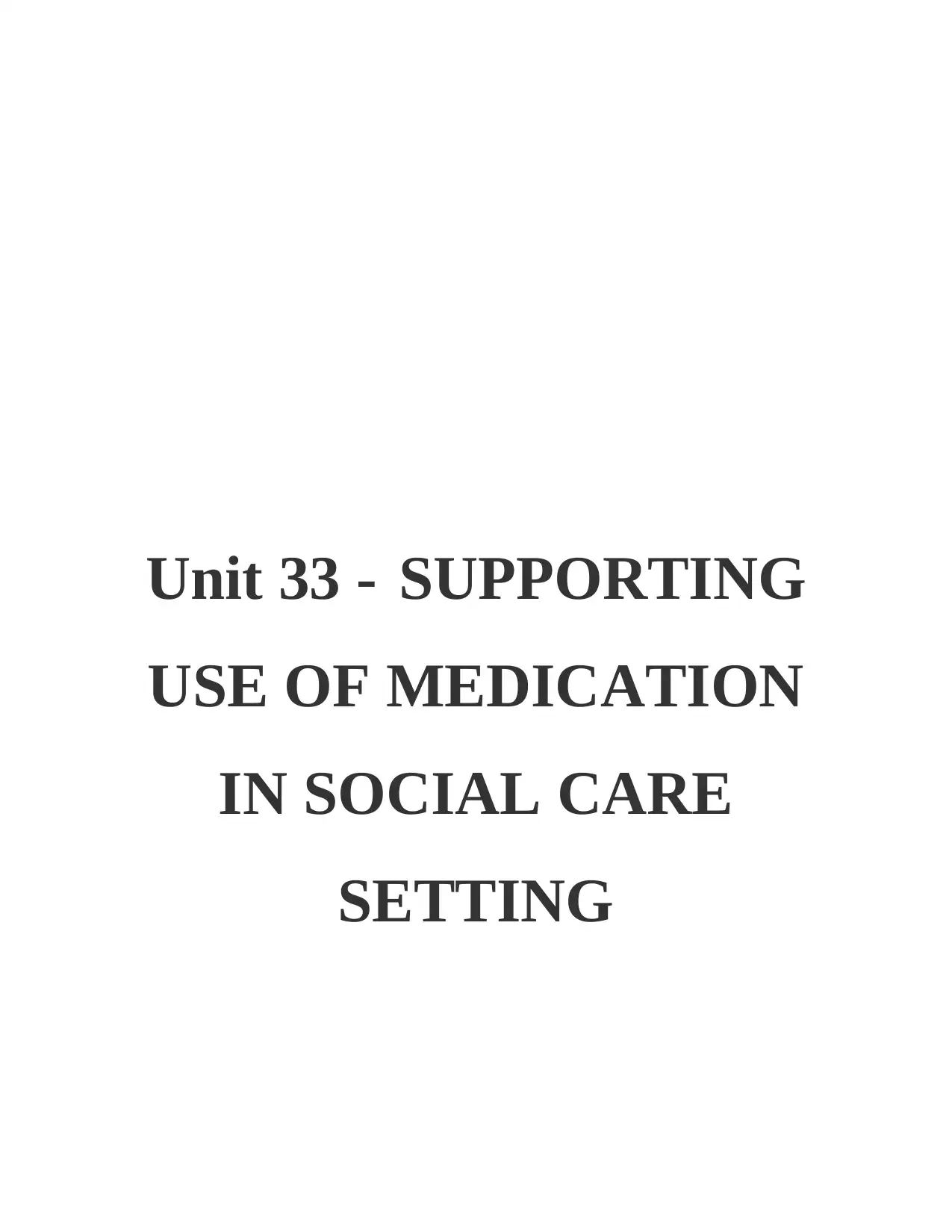
Unit 33 - SUPPORTING
USE OF MEDICATION
IN SOCIAL CARE
SETTING
USE OF MEDICATION
IN SOCIAL CARE
SETTING
Paraphrase This Document
Need a fresh take? Get an instant paraphrase of this document with our AI Paraphraser
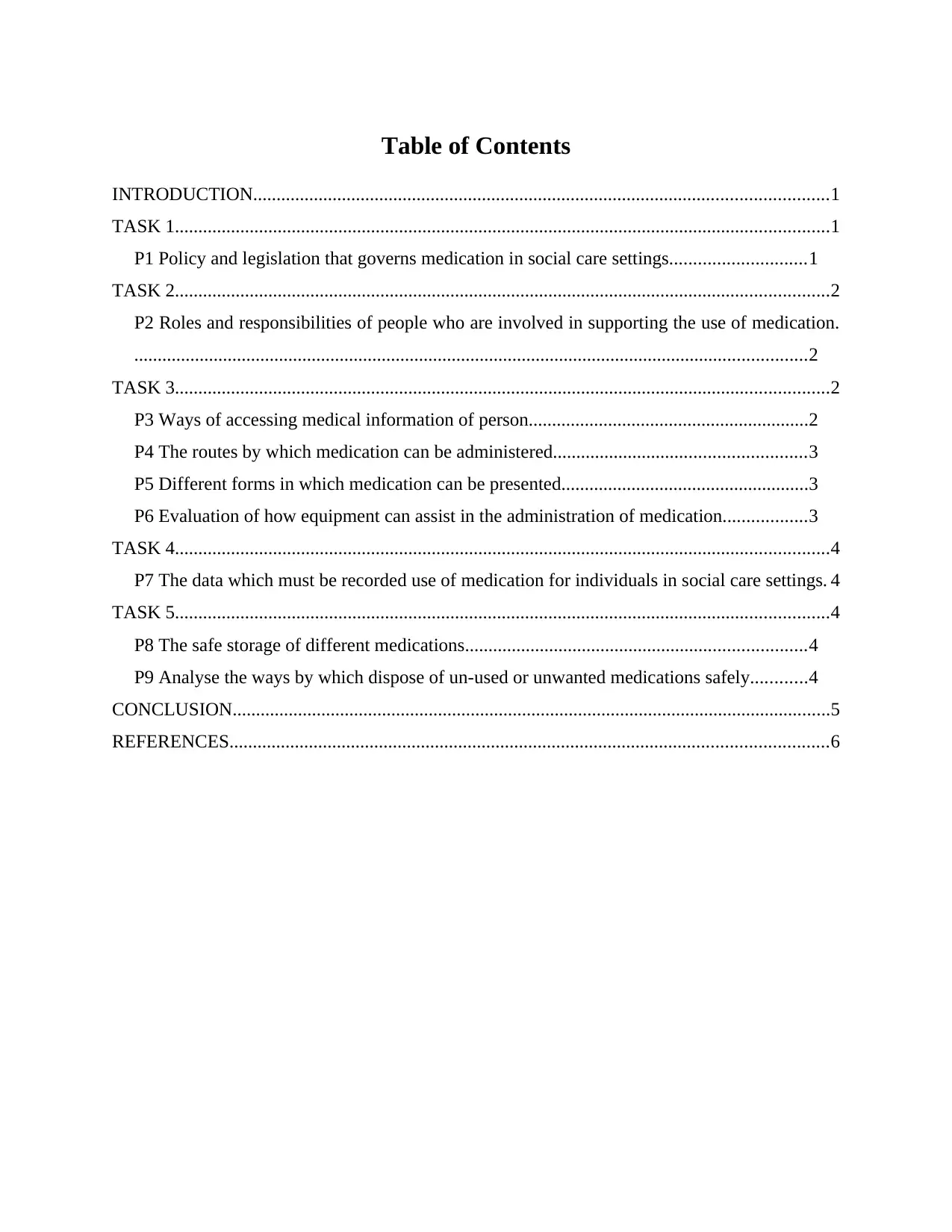
Table of Contents
INTRODUCTION...........................................................................................................................1
TASK 1............................................................................................................................................1
P1 Policy and legislation that governs medication in social care settings.............................1
TASK 2............................................................................................................................................2
P2 Roles and responsibilities of people who are involved in supporting the use of medication.
................................................................................................................................................2
TASK 3............................................................................................................................................2
P3 Ways of accessing medical information of person............................................................2
P4 The routes by which medication can be administered......................................................3
P5 Different forms in which medication can be presented.....................................................3
P6 Evaluation of how equipment can assist in the administration of medication..................3
TASK 4............................................................................................................................................4
P7 The data which must be recorded use of medication for individuals in social care settings. 4
TASK 5............................................................................................................................................4
P8 The safe storage of different medications.........................................................................4
P9 Analyse the ways by which dispose of un-used or unwanted medications safely............4
CONCLUSION................................................................................................................................5
REFERENCES................................................................................................................................6
INTRODUCTION...........................................................................................................................1
TASK 1............................................................................................................................................1
P1 Policy and legislation that governs medication in social care settings.............................1
TASK 2............................................................................................................................................2
P2 Roles and responsibilities of people who are involved in supporting the use of medication.
................................................................................................................................................2
TASK 3............................................................................................................................................2
P3 Ways of accessing medical information of person............................................................2
P4 The routes by which medication can be administered......................................................3
P5 Different forms in which medication can be presented.....................................................3
P6 Evaluation of how equipment can assist in the administration of medication..................3
TASK 4............................................................................................................................................4
P7 The data which must be recorded use of medication for individuals in social care settings. 4
TASK 5............................................................................................................................................4
P8 The safe storage of different medications.........................................................................4
P9 Analyse the ways by which dispose of un-used or unwanted medications safely............4
CONCLUSION................................................................................................................................5
REFERENCES................................................................................................................................6
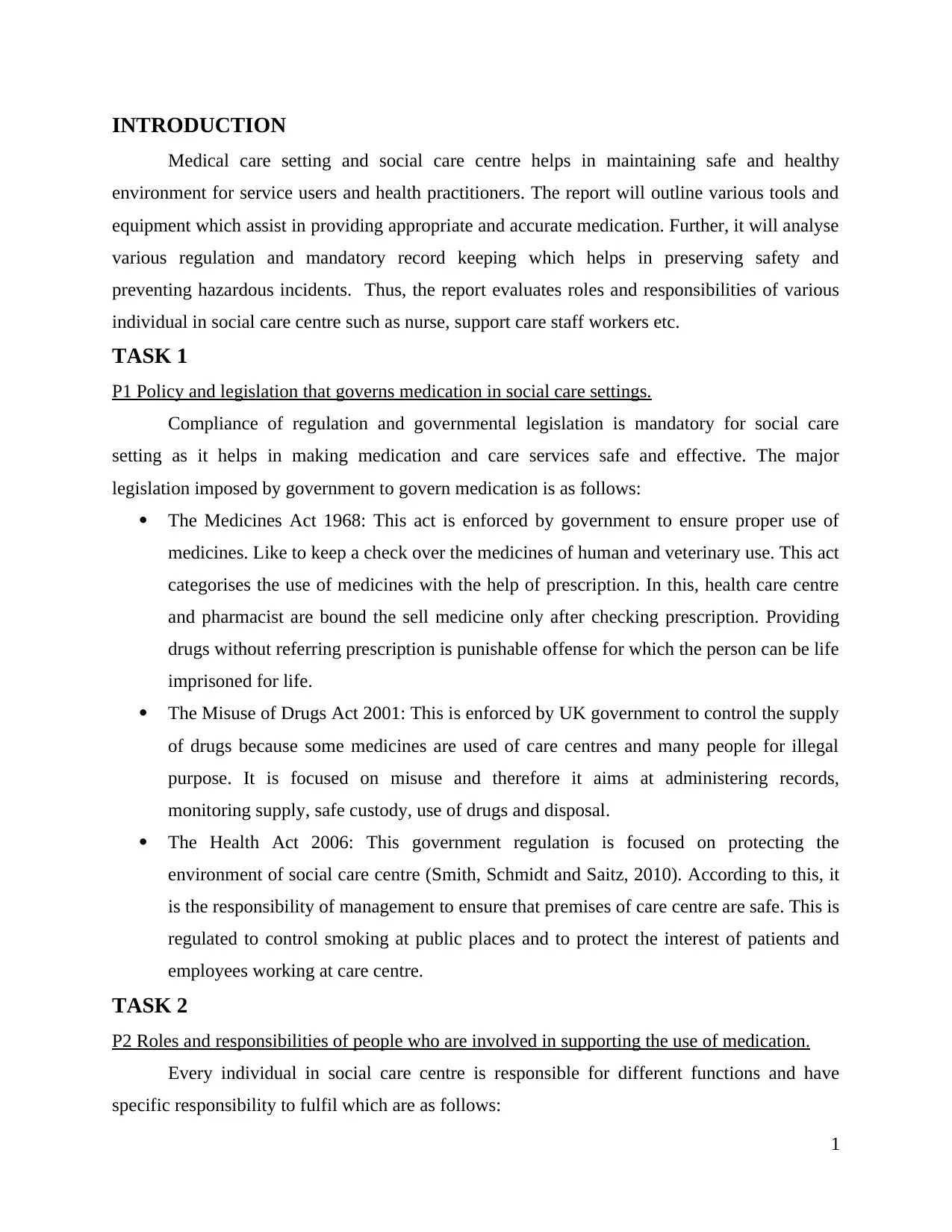
INTRODUCTION
Medical care setting and social care centre helps in maintaining safe and healthy
environment for service users and health practitioners. The report will outline various tools and
equipment which assist in providing appropriate and accurate medication. Further, it will analyse
various regulation and mandatory record keeping which helps in preserving safety and
preventing hazardous incidents. Thus, the report evaluates roles and responsibilities of various
individual in social care centre such as nurse, support care staff workers etc.
TASK 1
P1 Policy and legislation that governs medication in social care settings.
Compliance of regulation and governmental legislation is mandatory for social care
setting as it helps in making medication and care services safe and effective. The major
legislation imposed by government to govern medication is as follows:
The Medicines Act 1968: This act is enforced by government to ensure proper use of
medicines. Like to keep a check over the medicines of human and veterinary use. This act
categorises the use of medicines with the help of prescription. In this, health care centre
and pharmacist are bound the sell medicine only after checking prescription. Providing
drugs without referring prescription is punishable offense for which the person can be life
imprisoned for life.
The Misuse of Drugs Act 2001: This is enforced by UK government to control the supply
of drugs because some medicines are used of care centres and many people for illegal
purpose. It is focused on misuse and therefore it aims at administering records,
monitoring supply, safe custody, use of drugs and disposal.
The Health Act 2006: This government regulation is focused on protecting the
environment of social care centre (Smith, Schmidt and Saitz, 2010). According to this, it
is the responsibility of management to ensure that premises of care centre are safe. This is
regulated to control smoking at public places and to protect the interest of patients and
employees working at care centre.
TASK 2
P2 Roles and responsibilities of people who are involved in supporting the use of medication.
Every individual in social care centre is responsible for different functions and have
specific responsibility to fulfil which are as follows:
1
Medical care setting and social care centre helps in maintaining safe and healthy
environment for service users and health practitioners. The report will outline various tools and
equipment which assist in providing appropriate and accurate medication. Further, it will analyse
various regulation and mandatory record keeping which helps in preserving safety and
preventing hazardous incidents. Thus, the report evaluates roles and responsibilities of various
individual in social care centre such as nurse, support care staff workers etc.
TASK 1
P1 Policy and legislation that governs medication in social care settings.
Compliance of regulation and governmental legislation is mandatory for social care
setting as it helps in making medication and care services safe and effective. The major
legislation imposed by government to govern medication is as follows:
The Medicines Act 1968: This act is enforced by government to ensure proper use of
medicines. Like to keep a check over the medicines of human and veterinary use. This act
categorises the use of medicines with the help of prescription. In this, health care centre
and pharmacist are bound the sell medicine only after checking prescription. Providing
drugs without referring prescription is punishable offense for which the person can be life
imprisoned for life.
The Misuse of Drugs Act 2001: This is enforced by UK government to control the supply
of drugs because some medicines are used of care centres and many people for illegal
purpose. It is focused on misuse and therefore it aims at administering records,
monitoring supply, safe custody, use of drugs and disposal.
The Health Act 2006: This government regulation is focused on protecting the
environment of social care centre (Smith, Schmidt and Saitz, 2010). According to this, it
is the responsibility of management to ensure that premises of care centre are safe. This is
regulated to control smoking at public places and to protect the interest of patients and
employees working at care centre.
TASK 2
P2 Roles and responsibilities of people who are involved in supporting the use of medication.
Every individual in social care centre is responsible for different functions and have
specific responsibility to fulfil which are as follows:
1
⊘ This is a preview!⊘
Do you want full access?
Subscribe today to unlock all pages.

Trusted by 1+ million students worldwide
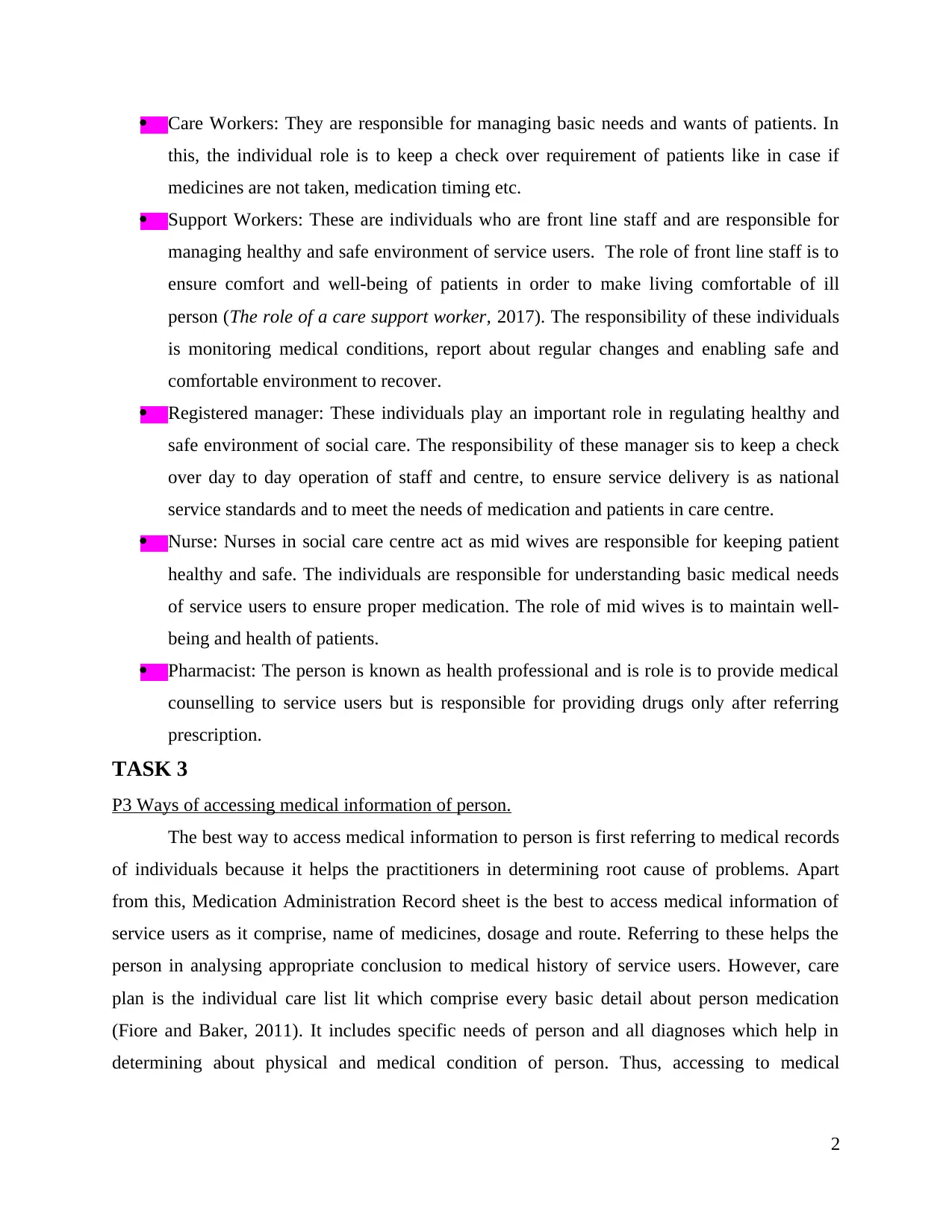
Care Workers: They are responsible for managing basic needs and wants of patients. In
this, the individual role is to keep a check over requirement of patients like in case if
medicines are not taken, medication timing etc.
Support Workers: These are individuals who are front line staff and are responsible for
managing healthy and safe environment of service users. The role of front line staff is to
ensure comfort and well-being of patients in order to make living comfortable of ill
person (The role of a care support worker, 2017). The responsibility of these individuals
is monitoring medical conditions, report about regular changes and enabling safe and
comfortable environment to recover.
Registered manager: These individuals play an important role in regulating healthy and
safe environment of social care. The responsibility of these manager sis to keep a check
over day to day operation of staff and centre, to ensure service delivery is as national
service standards and to meet the needs of medication and patients in care centre.
Nurse: Nurses in social care centre act as mid wives are responsible for keeping patient
healthy and safe. The individuals are responsible for understanding basic medical needs
of service users to ensure proper medication. The role of mid wives is to maintain well-
being and health of patients.
Pharmacist: The person is known as health professional and is role is to provide medical
counselling to service users but is responsible for providing drugs only after referring
prescription.
TASK 3
P3 Ways of accessing medical information of person.
The best way to access medical information to person is first referring to medical records
of individuals because it helps the practitioners in determining root cause of problems. Apart
from this, Medication Administration Record sheet is the best to access medical information of
service users as it comprise, name of medicines, dosage and route. Referring to these helps the
person in analysing appropriate conclusion to medical history of service users. However, care
plan is the individual care list lit which comprise every basic detail about person medication
(Fiore and Baker, 2011). It includes specific needs of person and all diagnoses which help in
determining about physical and medical condition of person. Thus, accessing to medical
2
this, the individual role is to keep a check over requirement of patients like in case if
medicines are not taken, medication timing etc.
Support Workers: These are individuals who are front line staff and are responsible for
managing healthy and safe environment of service users. The role of front line staff is to
ensure comfort and well-being of patients in order to make living comfortable of ill
person (The role of a care support worker, 2017). The responsibility of these individuals
is monitoring medical conditions, report about regular changes and enabling safe and
comfortable environment to recover.
Registered manager: These individuals play an important role in regulating healthy and
safe environment of social care. The responsibility of these manager sis to keep a check
over day to day operation of staff and centre, to ensure service delivery is as national
service standards and to meet the needs of medication and patients in care centre.
Nurse: Nurses in social care centre act as mid wives are responsible for keeping patient
healthy and safe. The individuals are responsible for understanding basic medical needs
of service users to ensure proper medication. The role of mid wives is to maintain well-
being and health of patients.
Pharmacist: The person is known as health professional and is role is to provide medical
counselling to service users but is responsible for providing drugs only after referring
prescription.
TASK 3
P3 Ways of accessing medical information of person.
The best way to access medical information to person is first referring to medical records
of individuals because it helps the practitioners in determining root cause of problems. Apart
from this, Medication Administration Record sheet is the best to access medical information of
service users as it comprise, name of medicines, dosage and route. Referring to these helps the
person in analysing appropriate conclusion to medical history of service users. However, care
plan is the individual care list lit which comprise every basic detail about person medication
(Fiore and Baker, 2011). It includes specific needs of person and all diagnoses which help in
determining about physical and medical condition of person. Thus, accessing to medical
2
Paraphrase This Document
Need a fresh take? Get an instant paraphrase of this document with our AI Paraphraser
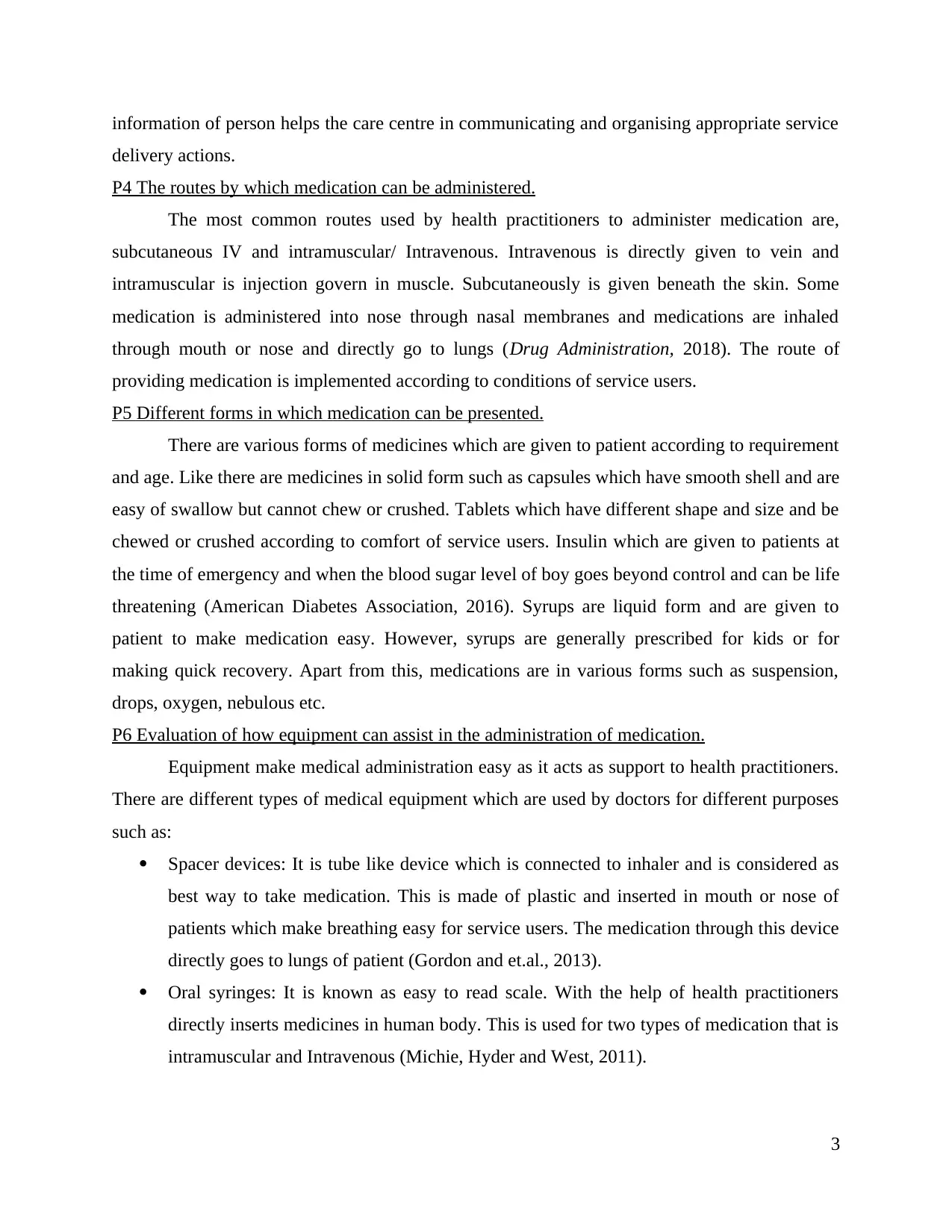
information of person helps the care centre in communicating and organising appropriate service
delivery actions.
P4 The routes by which medication can be administered.
The most common routes used by health practitioners to administer medication are,
subcutaneous IV and intramuscular/ Intravenous. Intravenous is directly given to vein and
intramuscular is injection govern in muscle. Subcutaneously is given beneath the skin. Some
medication is administered into nose through nasal membranes and medications are inhaled
through mouth or nose and directly go to lungs (Drug Administration, 2018). The route of
providing medication is implemented according to conditions of service users.
P5 Different forms in which medication can be presented.
There are various forms of medicines which are given to patient according to requirement
and age. Like there are medicines in solid form such as capsules which have smooth shell and are
easy of swallow but cannot chew or crushed. Tablets which have different shape and size and be
chewed or crushed according to comfort of service users. Insulin which are given to patients at
the time of emergency and when the blood sugar level of boy goes beyond control and can be life
threatening (American Diabetes Association, 2016). Syrups are liquid form and are given to
patient to make medication easy. However, syrups are generally prescribed for kids or for
making quick recovery. Apart from this, medications are in various forms such as suspension,
drops, oxygen, nebulous etc.
P6 Evaluation of how equipment can assist in the administration of medication.
Equipment make medical administration easy as it acts as support to health practitioners.
There are different types of medical equipment which are used by doctors for different purposes
such as:
Spacer devices: It is tube like device which is connected to inhaler and is considered as
best way to take medication. This is made of plastic and inserted in mouth or nose of
patients which make breathing easy for service users. The medication through this device
directly goes to lungs of patient (Gordon and et.al., 2013).
Oral syringes: It is known as easy to read scale. With the help of health practitioners
directly inserts medicines in human body. This is used for two types of medication that is
intramuscular and Intravenous (Michie, Hyder and West, 2011).
3
delivery actions.
P4 The routes by which medication can be administered.
The most common routes used by health practitioners to administer medication are,
subcutaneous IV and intramuscular/ Intravenous. Intravenous is directly given to vein and
intramuscular is injection govern in muscle. Subcutaneously is given beneath the skin. Some
medication is administered into nose through nasal membranes and medications are inhaled
through mouth or nose and directly go to lungs (Drug Administration, 2018). The route of
providing medication is implemented according to conditions of service users.
P5 Different forms in which medication can be presented.
There are various forms of medicines which are given to patient according to requirement
and age. Like there are medicines in solid form such as capsules which have smooth shell and are
easy of swallow but cannot chew or crushed. Tablets which have different shape and size and be
chewed or crushed according to comfort of service users. Insulin which are given to patients at
the time of emergency and when the blood sugar level of boy goes beyond control and can be life
threatening (American Diabetes Association, 2016). Syrups are liquid form and are given to
patient to make medication easy. However, syrups are generally prescribed for kids or for
making quick recovery. Apart from this, medications are in various forms such as suspension,
drops, oxygen, nebulous etc.
P6 Evaluation of how equipment can assist in the administration of medication.
Equipment make medical administration easy as it acts as support to health practitioners.
There are different types of medical equipment which are used by doctors for different purposes
such as:
Spacer devices: It is tube like device which is connected to inhaler and is considered as
best way to take medication. This is made of plastic and inserted in mouth or nose of
patients which make breathing easy for service users. The medication through this device
directly goes to lungs of patient (Gordon and et.al., 2013).
Oral syringes: It is known as easy to read scale. With the help of health practitioners
directly inserts medicines in human body. This is used for two types of medication that is
intramuscular and Intravenous (Michie, Hyder and West, 2011).
3
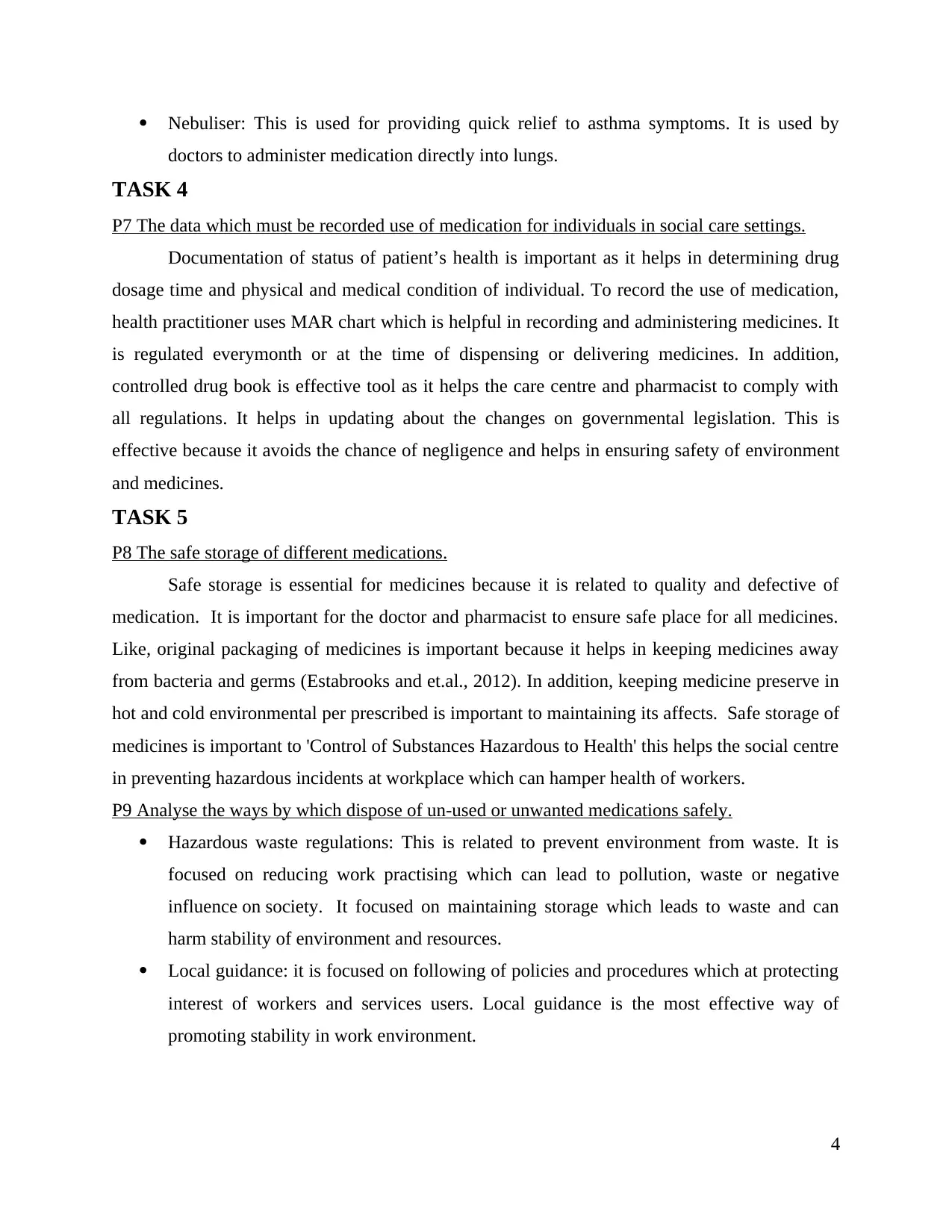
Nebuliser: This is used for providing quick relief to asthma symptoms. It is used by
doctors to administer medication directly into lungs.
TASK 4
P7 The data which must be recorded use of medication for individuals in social care settings.
Documentation of status of patient’s health is important as it helps in determining drug
dosage time and physical and medical condition of individual. To record the use of medication,
health practitioner uses MAR chart which is helpful in recording and administering medicines. It
is regulated everymonth or at the time of dispensing or delivering medicines. In addition,
controlled drug book is effective tool as it helps the care centre and pharmacist to comply with
all regulations. It helps in updating about the changes on governmental legislation. This is
effective because it avoids the chance of negligence and helps in ensuring safety of environment
and medicines.
TASK 5
P8 The safe storage of different medications.
Safe storage is essential for medicines because it is related to quality and defective of
medication. It is important for the doctor and pharmacist to ensure safe place for all medicines.
Like, original packaging of medicines is important because it helps in keeping medicines away
from bacteria and germs (Estabrooks and et.al., 2012). In addition, keeping medicine preserve in
hot and cold environmental per prescribed is important to maintaining its affects. Safe storage of
medicines is important to 'Control of Substances Hazardous to Health' this helps the social centre
in preventing hazardous incidents at workplace which can hamper health of workers.
P9 Analyse the ways by which dispose of un-used or unwanted medications safely.
Hazardous waste regulations: This is related to prevent environment from waste. It is
focused on reducing work practising which can lead to pollution, waste or negative
influence on society. It focused on maintaining storage which leads to waste and can
harm stability of environment and resources.
Local guidance: it is focused on following of policies and procedures which at protecting
interest of workers and services users. Local guidance is the most effective way of
promoting stability in work environment.
4
doctors to administer medication directly into lungs.
TASK 4
P7 The data which must be recorded use of medication for individuals in social care settings.
Documentation of status of patient’s health is important as it helps in determining drug
dosage time and physical and medical condition of individual. To record the use of medication,
health practitioner uses MAR chart which is helpful in recording and administering medicines. It
is regulated everymonth or at the time of dispensing or delivering medicines. In addition,
controlled drug book is effective tool as it helps the care centre and pharmacist to comply with
all regulations. It helps in updating about the changes on governmental legislation. This is
effective because it avoids the chance of negligence and helps in ensuring safety of environment
and medicines.
TASK 5
P8 The safe storage of different medications.
Safe storage is essential for medicines because it is related to quality and defective of
medication. It is important for the doctor and pharmacist to ensure safe place for all medicines.
Like, original packaging of medicines is important because it helps in keeping medicines away
from bacteria and germs (Estabrooks and et.al., 2012). In addition, keeping medicine preserve in
hot and cold environmental per prescribed is important to maintaining its affects. Safe storage of
medicines is important to 'Control of Substances Hazardous to Health' this helps the social centre
in preventing hazardous incidents at workplace which can hamper health of workers.
P9 Analyse the ways by which dispose of un-used or unwanted medications safely.
Hazardous waste regulations: This is related to prevent environment from waste. It is
focused on reducing work practising which can lead to pollution, waste or negative
influence on society. It focused on maintaining storage which leads to waste and can
harm stability of environment and resources.
Local guidance: it is focused on following of policies and procedures which at protecting
interest of workers and services users. Local guidance is the most effective way of
promoting stability in work environment.
4
⊘ This is a preview!⊘
Do you want full access?
Subscribe today to unlock all pages.

Trusted by 1+ million students worldwide
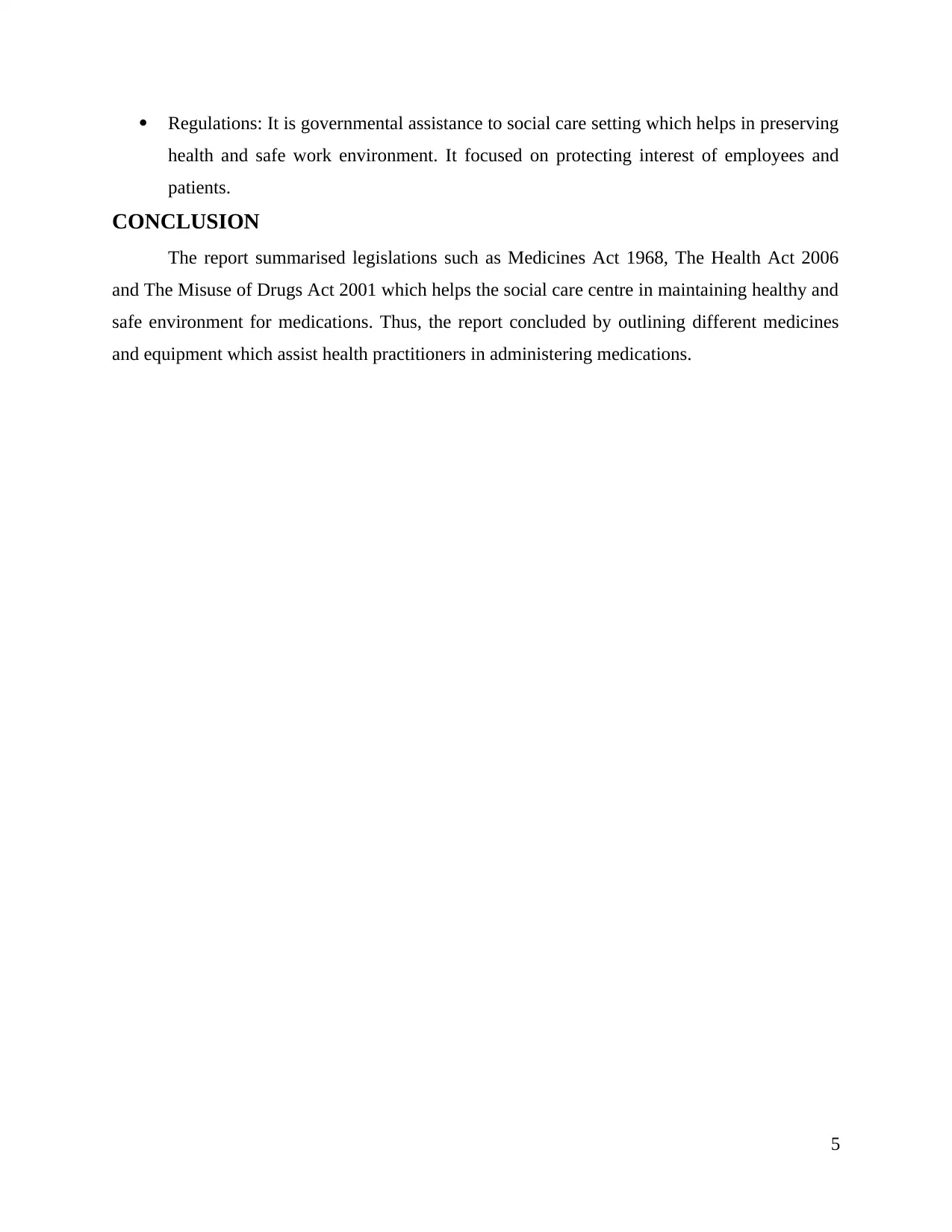
Regulations: It is governmental assistance to social care setting which helps in preserving
health and safe work environment. It focused on protecting interest of employees and
patients.
CONCLUSION
The report summarised legislations such as Medicines Act 1968, The Health Act 2006
and The Misuse of Drugs Act 2001 which helps the social care centre in maintaining healthy and
safe environment for medications. Thus, the report concluded by outlining different medicines
and equipment which assist health practitioners in administering medications.
5
health and safe work environment. It focused on protecting interest of employees and
patients.
CONCLUSION
The report summarised legislations such as Medicines Act 1968, The Health Act 2006
and The Misuse of Drugs Act 2001 which helps the social care centre in maintaining healthy and
safe environment for medications. Thus, the report concluded by outlining different medicines
and equipment which assist health practitioners in administering medications.
5
Paraphrase This Document
Need a fresh take? Get an instant paraphrase of this document with our AI Paraphraser
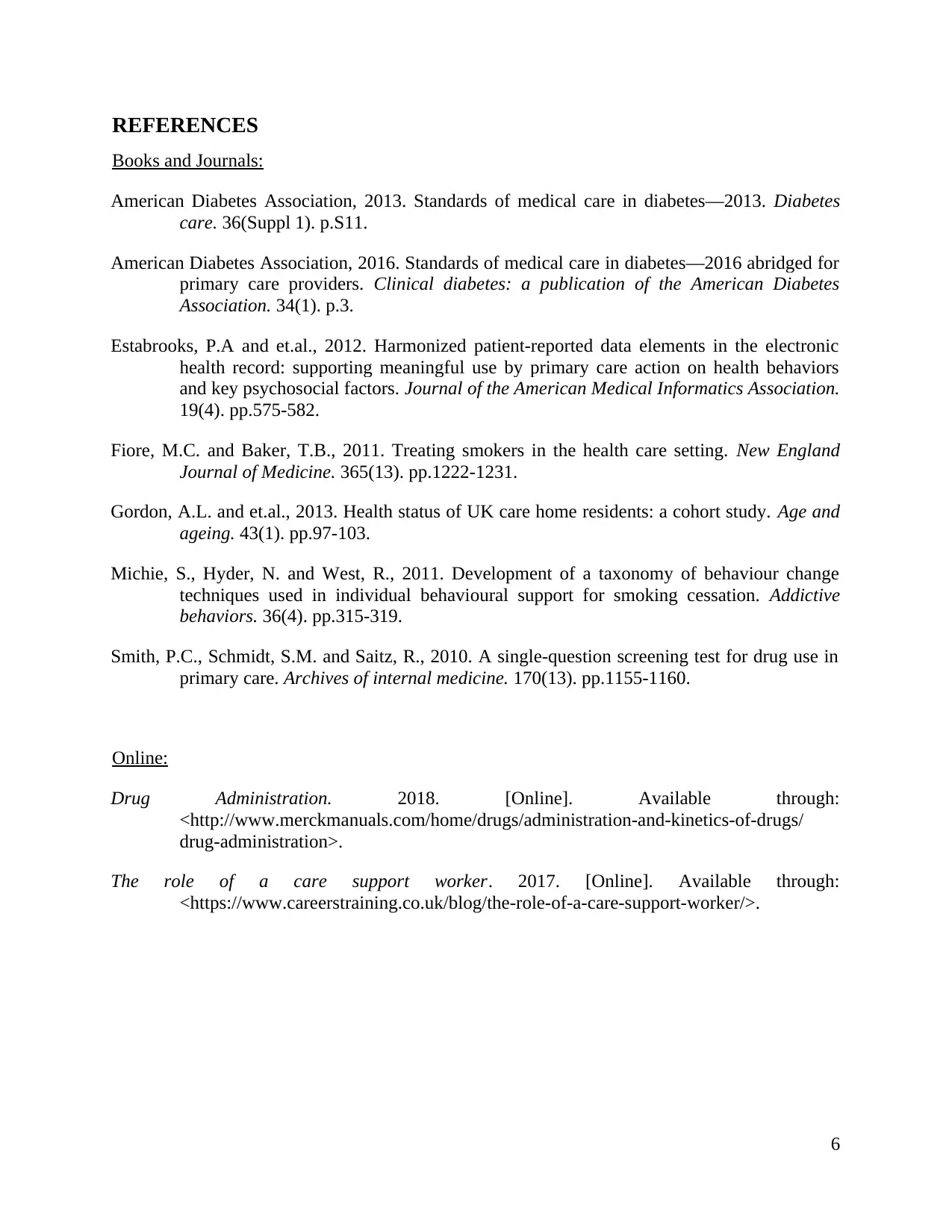
REFERENCES
Books and Journals:
American Diabetes Association, 2013. Standards of medical care in diabetes—2013. Diabetes
care. 36(Suppl 1). p.S11.
American Diabetes Association, 2016. Standards of medical care in diabetes—2016 abridged for
primary care providers. Clinical diabetes: a publication of the American Diabetes
Association. 34(1). p.3.
Estabrooks, P.A and et.al., 2012. Harmonized patient-reported data elements in the electronic
health record: supporting meaningful use by primary care action on health behaviors
and key psychosocial factors. Journal of the American Medical Informatics Association.
19(4). pp.575-582.
Fiore, M.C. and Baker, T.B., 2011. Treating smokers in the health care setting. New England
Journal of Medicine. 365(13). pp.1222-1231.
Gordon, A.L. and et.al., 2013. Health status of UK care home residents: a cohort study. Age and
ageing. 43(1). pp.97-103.
Michie, S., Hyder, N. and West, R., 2011. Development of a taxonomy of behaviour change
techniques used in individual behavioural support for smoking cessation. Addictive
behaviors. 36(4). pp.315-319.
Smith, P.C., Schmidt, S.M. and Saitz, R., 2010. A single-question screening test for drug use in
primary care. Archives of internal medicine. 170(13). pp.1155-1160.
Online:
Drug Administration. 2018. [Online]. Available through:
<http://www.merckmanuals.com/home/drugs/administration-and-kinetics-of-drugs/
drug-administration>.
The role of a care support worker. 2017. [Online]. Available through:
<https://www.careerstraining.co.uk/blog/the-role-of-a-care-support-worker/>.
6
Books and Journals:
American Diabetes Association, 2013. Standards of medical care in diabetes—2013. Diabetes
care. 36(Suppl 1). p.S11.
American Diabetes Association, 2016. Standards of medical care in diabetes—2016 abridged for
primary care providers. Clinical diabetes: a publication of the American Diabetes
Association. 34(1). p.3.
Estabrooks, P.A and et.al., 2012. Harmonized patient-reported data elements in the electronic
health record: supporting meaningful use by primary care action on health behaviors
and key psychosocial factors. Journal of the American Medical Informatics Association.
19(4). pp.575-582.
Fiore, M.C. and Baker, T.B., 2011. Treating smokers in the health care setting. New England
Journal of Medicine. 365(13). pp.1222-1231.
Gordon, A.L. and et.al., 2013. Health status of UK care home residents: a cohort study. Age and
ageing. 43(1). pp.97-103.
Michie, S., Hyder, N. and West, R., 2011. Development of a taxonomy of behaviour change
techniques used in individual behavioural support for smoking cessation. Addictive
behaviors. 36(4). pp.315-319.
Smith, P.C., Schmidt, S.M. and Saitz, R., 2010. A single-question screening test for drug use in
primary care. Archives of internal medicine. 170(13). pp.1155-1160.
Online:
Drug Administration. 2018. [Online]. Available through:
<http://www.merckmanuals.com/home/drugs/administration-and-kinetics-of-drugs/
drug-administration>.
The role of a care support worker. 2017. [Online]. Available through:
<https://www.careerstraining.co.uk/blog/the-role-of-a-care-support-worker/>.
6
1 out of 8
Related Documents
Your All-in-One AI-Powered Toolkit for Academic Success.
+13062052269
info@desklib.com
Available 24*7 on WhatsApp / Email
![[object Object]](/_next/static/media/star-bottom.7253800d.svg)
Unlock your academic potential
Copyright © 2020–2025 A2Z Services. All Rights Reserved. Developed and managed by ZUCOL.





